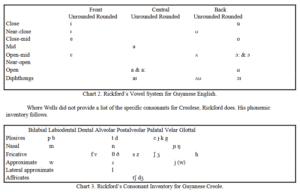As mentioned, the British and Dutch brought Indians from India in the 1800s into the Caribbean as indentured laborers to work on sugar cane plantations. The purpose of doing this was to replace African American slaves after slavery was finally abolished. Many were brought to countries like Guyana and left their families and lives in India hoping for a better future, as the British colonial policy aimed to settle immigrants in the country to ensure a convenient source of inexpensive labor for the sugar plantations. Many Indians remained in Guyana as they believed it was more difficult to support themselves back in India. The Indians who remained in the Caribbean are considered “Indo-Caribbean”.
As new immigrants from India kept coming into the country during the indentureship period, there was a need for the speakers to keep their mother tongue alive. However, plantation owners along with British authorities, promoted the use of English for social and integration into the British colonial system. Linguistic fusion occurred as Hindi speakers were exposed to English, incorporating English words and phrases into their Hindi centered communication. Over time, this fusion between Hindi and English, along with elements from Portuguese, African, Dutch and more have evolved into Guyanese Creole.
Hindi has influenced Guyanese Creole through linguistic borrowing and integration of Hindi words, expressions and grammar into the creole due to this migration. The influence can be observed in vocabulary, phonology and syntax. The influence of Hindi in Guyanese Creole is most apparent within vocabulary. Guyanese creole has borrowed an extensive number of words directly from Hindi. Many of the Hindi words that have survived within the present time have been mostly due to religious beliefs and purposes (Hinduism) as many Hindus value tradition. For example the word “Aarti”, which in Hinduism is used for worship in which a thari (brass plate) is circulated around the object of worship However, there are many other borrowed words that have become an integral part of Guyanese Creole’s lexicon, that are not directly tied to religious contexts.
For example, Guyanese people still incorporate some of our ancestral Hindi into our day to day speaking. One strong example of this exists in our names for cultural dishes. Many West Indian people to date, utilize the Hindi name of vegetables in our day to day cooking. The linguistic borrow shows us the influence of the Indian community. This influence has significantly impacted the culinary heritage and daily life in Guyana and the Caribbean, as the two cultures fuse together adding diversity to the language and cuisine.
Here are a few food and vegetable names Guyanese Creole has borrowed from Hindi:
Achar : Condiment made with masala; pickle
Aloo: Potato
Baigan: Eggplant
Bhaji: Spinach
Bhunjal: A dry curry
Bora: Long beans
Caraila: Bitter Melon
Catahar: Jackfruit
Channa: Chickpeas
Dhal: Split peas
Dahi: Yogurt
Halwa: Sweet dessert
Jira: Cumin-Masala
Masala: Mix of spices
Puri: Fried bread
Roti: Indian bread
Surwah: Gravy from the curry
Resources:
The History and Complexity of Being Indo-Caribbean. The Diversity Story. https://www.thediversitystory.org/post/the-history-and-complexity-of-being-indo-caribbean
The Hindi Language in Multicultural Guyana. Randall Butisignh’s Weblog. https://randallbutisingh.wordpress.com/2008/04/13/thought-for-today-137/
The loss of the ancestral language of Indo-Guyanese. Stabroek News. https://www.stabroeknews.com/2021/05/05/features/the-loss-of-the-ancestral-language-of-indo-guyanese/


